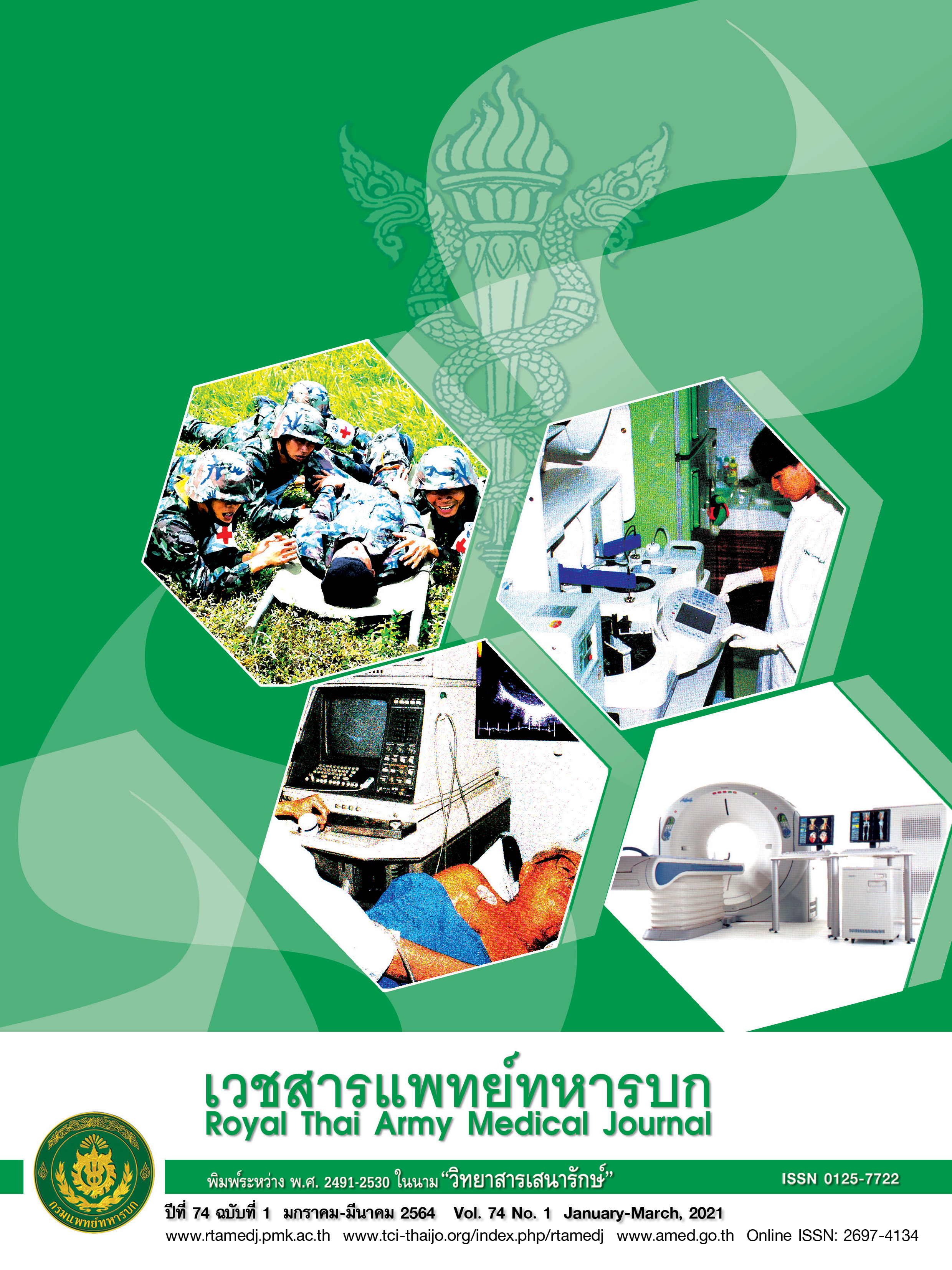ผลของอุณหภูมิต่อประสิทธิภาพของกรดเปอราซิติกในการกำจัดเชื้อราในตัวกรองเลือดที่ใช้ซ้ำ ผลของอุณหภูมิต่อประสิทธิภาพของกรดเปอราซิติกในการกำจัดเชื้อราในตัวกรองเลือดที่ใช้ซ้ำ
Main Article Content
บทคัดย่อ
บทนำ การสลายตัวของกรดเปอราซิติกในกระบวนการนำตัวกรองเลือดกลับมาใช้ซ้ำแปรผันตามระดับอุณหภูมิที่สูงขึ้น วัตถุประสงค์ เพื่อศึกษาประสิทธิภาพของกรดเปอราซิติก 0.16% ในตัวกรองเลือดที่ใช้ซ้ำต่อการกำจัดเชื้อCandida albicans และ Aspergillus niger ที่อุณหภูมิ 35 ถึง 50 องศาเซลเซียส (ซ.) เวลา 0 ถึง 96 ชั่วโมง(ชม.) วัสดุและวิธีการ แบ่งตัวกรองเลือดจำนวน 20 ตัวแบบสุ่มเป็น 1.1) กลุ่มควบคุมคือตัวกรองที่ปนเปื้อน C. albicans 1.2) กลุ่มทดลองคือตัวกรองที่ปนเปื้อน C. albicans ที่มีกรดเปอราซิติก 2.1) กลุ่มควบคุมคือตัวกรองที่ปนเปื้อน A. niger และ 2.2) กลุ่มทดลองคือตัวกรองที่ปนเปื้อน A. niger ที่มีกรดเปอราซิติก จากนั้นทดสอบความเข้มข้นคงเหลือของกรดเปอราซิติกในกลุ่มทดลองด้วยแผ่นทดสอบ ผลการศึกษา ในกลุ่มทดลอง 1.2) และ 2.2) ที่อุณหภูมิ 35, 40, และ 45 ซ. พบว่า กรดเปอราซิติกเริ่มสลายตัวที่ 48 ชม. โดยที่ 96 ชม. สลายตัวจาก 2,000 เหลือ 1,500 ppm ณ อุณหภูมิ 35 ซ. และลดลงเหลือ 1000 ppm ที่อุณหภูมิ 40 และ 45 ซ. ตรวจพบการสลายตัวสูงสุดที่อุณหภูมิ 50 °ซ. เท่ากับ 1,500 และ 800 ppm ที่ 24 และ 96 ชม. แม้สารจะสลายตัวตามอุณหภูมิที่สูงขึ้นแต่พบว่าฤทธิ์ของสารในกลุ่มทดลองยังสามารถยับยั้งการเจริญเติบโตของเชื้อราทั้งสองชนิดได้ ดังนั้นความเข้มข้นที่เหลืออยู่เพียงพอต่อการฆ่าเชื้อโรค สรุป ควรกำหนดความเข้มข้นของกรดเปอราซิติกที่ใช้ในตัวกรองเลือดที่ใช้ซ้ำเมื่ออุณหภูมิสูงขึ้น โดยให้มีค่าก่อนและหลังทำการอบตัวกรองอย่างน้อยที่ 2,000 ppm และ 800 ppm ตามลำดับ
Downloads
Article Details
บทความในวารสารนี้อยู่ภายใต้ลิขสิทธิ์ของ กรมแพทย์ทหารบก และเผยแพร่ภายใต้สัญญาอนุญาต Creative Commons Attribution-NonCommercial-NoDerivatives 4.0 International (CC BY-NC-ND 4.0)
ท่านสามารถอ่านและใช้งานเพื่อวัตถุประสงค์ทางการศึกษา และทางวิชาการ เช่น การสอน การวิจัย หรือการอ้างอิง โดยต้องให้เครดิตอย่างเหมาะสมแก่ผู้เขียนและวารสาร
ห้ามใช้หรือแก้ไขบทความโดยไม่ได้รับอนุญาต
ข้อความที่ปรากฏในบทความเป็นความคิดเห็นของผู้เขียนเท่านั้น
ผู้เขียนเป็นผู้รับผิดชอบต่อเนื้อหาและความถูกต้องของบทความของตนอย่างเต็มที่
การนำบทความไปเผยแพร่ซ้ำในรูปแบบสาธารณะอื่นใด ต้องได้รับอนุญาตจากวารสาร
เอกสารอ้างอิง
2.Kitis M. Disinfection of wastewater with peracetic acid: a review. Environ Int 2004;30:47- 55.
3.Canavese C, Petrarulo M, Massarenti P, Berutti S, Fenoglio R, Pauletto D, et al. Long term, low-dose, intravenous vitamin C leads to plasma calcium oxalate supersaturation in hemodialysis patients. Am J Kidney Dis 2005;45:540-9.
4.Kunigk L GD, Forte F, Vidal KP, Gomes LF, Sousa PF. The influence of temperature on the decomposition kinetics of peracetic acid in solutions. Braz J Chem Eng 2001;18:217-20.
5.Phowichit S, Ussawawongaraya W, Phusantisampan T, Spilles N, Rattanawong W. The influence of temperature on peracetic acid efficiency in dialyzer reuse. JNST 2017;23:52-7
6.Babic MN G-CN, Vargha M, Tischner Z, Magyar D, Veríssimo C, Sabino R, et al. Fungal Contaminants in Drinking Water Regulation? A Tale of Ecology, Exposure, Purification and Clinical Relevance. Int J Environ Res Public Health 2017;14:1-44.
7.Walsh TJ, Groll A, Hiemenz J, Fleming R, Roilides E, Anaissie E. Infections due to emerging and uncommon medically important fungal pathogens. Clin Microbiol Infect 2004;10 (Suppl 1):48-66.
8.Garcia-Rubio R, de Oliveira HC, Rivera J, Trevijano-Contador N. The Fungal Cell Wall: Candida, Cryptococcus, and Aspergillus Species. Front Microbiol.2019;10:1-13.
9.Donlan RM. Biofilms: microbial life on surfaces. Emerg Infect Dis 2002;8:881-90.
10.I.L. P. Biotic Characteristics of the Environment. Edition T, editor: Academic Press; 2019. 61-87 p.
11.R YBaR. Emerging Pathogens of the Candida Species: IntechOpen; 2018.
12.Mayer FL, Wilson D, Hube B. Candida albicans pathogenicity mechanisms. Virulence 2013;4:119-28.
13.Eguia A, Arakistain A, De-la-Pinta I, Lopez-Vicente J, Sevillano E, Quindos G, et al. Candida albicans biofilms on different materials for manufacturing implant abutments and prostheses. Med Oral Patol Oral Cir Bucal 2020;25:e13-20.
14.Chen S, Tsoi JKH, Tsang PCS, Park YJ, Song HJ, Matinlinna JP. Candida albicans aspects of binary titanium alloys for biomedical applications. Regen Biomater 2020;7:213-20.
15.Brunetti G, Navazio AS, Giuliani A, Giordano A, Proli EM, Antonelli G, et al. Candida blood stream infections observed between 2011 and 2016 in a large Italian University Hospital: A time-based retrospective analysis on epidemiology, biofilm production, antifungal agents consumption and drug-susceptibility. PLoS One 2019;14:1-17.
16.Vargas-Blanco D, Lynn A, Rosch J, Noreldin R, Salerni A, Lambert C, et al. A pre-therapeutic coating for medical devices that prevents the attachment of Candida albicans. Ann Clin Microbiol Antimicrob 2017;16:41.
17.Surapuram V, Setzer WN, McFeeters RL, McFeeters H. Antifungal activity of plant extracts against Aspergillus niger and Rhizopus stolonifer. Nat Prod Commun 2014;9:1603-5.
18.Person AK, Chudgar SM, Norton BL, Tong BC, Stout JE. Aspergillus niger: an unusual cause of invasive pulmonary aspergillosis. J Med Microbiol 2010;59):834-8.
19.Lin L, Zhao CH, Yin XY, Chen YL, Zhai HY, Xu CW, et al. Aspergillus niger bloodstream infection in gastric cancer after common hepatic artery embolization: A case report. Exp Ther Med 2017;14:1427-32.
20.Salim NL, Azhany Y, Abdul Rahman Z, Yusof R, Liza-Sharmini AT. Infected Baerveldt Glaucoma Drainage Device by Aspergillus niger. Case Rep Ophthalmol Med 2015;2015:1-3.
21.Arvanitidou M, Spaia S, Velegraki A, Pazarloglou M, Kanetidis D, Pangidis P, et al. High level of recovery of fungi from water and dialysate in haemodialysis units. J Hosp Infect 2000;45:225-30.
22.Figel IC, Marangoni PR, Tralamazza SM, Vicente VA, Dalzoto Pdo R, do Nascimento MM, et al. Black yeasts-like fungi isolated from dialysis water in hemodialysis units. Mycopathologia 2013;175:413-20.
23.Cai M, Sun P, Zhang L, Huang CH. UV/Peracetic Acid for Degradation of Pharmaceuticals and Reactive Species Evaluation. Environ Sci Technol 2017;51:14217-24.
24.Leypoldt JK MB, Pereira BJ, Levin NW, Petersen J, Jani A. Does reuse have clinically important effects on dialyzer function? Semin Dial 2000;13:281-90.
25.Bond TC NA, Krishnan M, Wilson SM, Mayne T. Dialyzer reuse with peracetic acid does not impact patient mortality. Clin J Am Soc Nephtol 2011;6:1368-74.
26.Nadeem SG SA, Hakim ST, Anjum Y, Kazm SU. Effect of growth media, pH and temperature on yeast to hyphal transition in Candica albicans. J Med Microbiol 2013;3:185-92.
27.DJ RWaW. Disinfection of endoscope: review of new chemical sterilants used for high-level disinfection. . Infect Control Hosp Epideminol 1999;20:69-76.
28.Bradley CR, Babb JR, Ayliffe GA. Evaluation of the Steris System 1 Peracetic Acid Endoscope Processor. J Hosp Infect 1995;29:143-51.
29.Products As. Cidex PA–Peracetic acid solution. Irvine 1998;CA (ASP):1-9.
30.Inupakutika MA, Sengupta S, Devireddy AR, Azad RK, Mittler R. The evolution of reactive oxygen species metabolism. J Exp Bot 2016;67:5933-43.
31.J de Andrade Junior DR, de Souza RB, dos Santos SA, de Andrade DR. Oxygen free radicals and pulmonary disease. J Bras Pneumol 2005; 31:60-8.
32.Palacios-CabreraI H, Taniwaki MH, Hashimoto JM, de Menezes HC. Growth of Aspergillus ochraceus, A. carbonarius and A. niger on culture media at different water activities and temperatures. Braz J Microbiol 2005;36:24-8.


